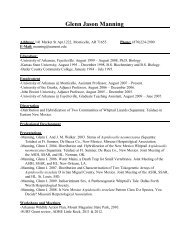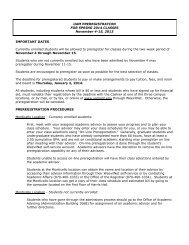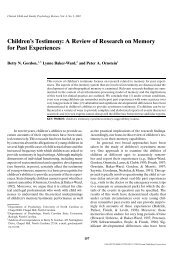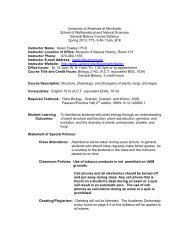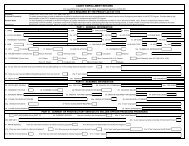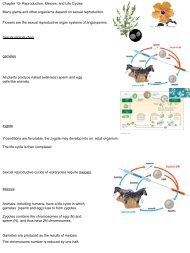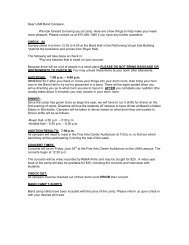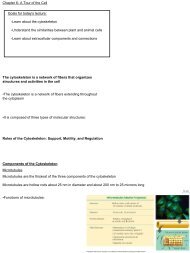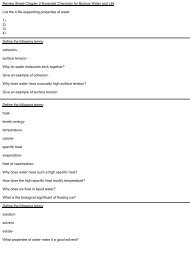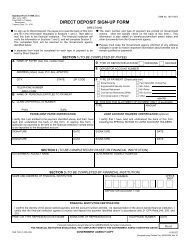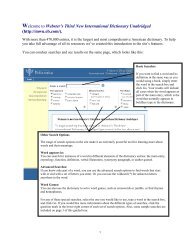The Two Major Types of Cells The Three Domains of Life 1. Bacteria ...
The Two Major Types of Cells The Three Domains of Life 1. Bacteria ...
The Two Major Types of Cells The Three Domains of Life 1. Bacteria ...
You also want an ePaper? Increase the reach of your titles
YUMPU automatically turns print PDFs into web optimized ePapers that Google loves.
<strong>The</strong> <strong>Two</strong> <strong>Major</strong> <strong>Types</strong> <strong>of</strong> <strong>Cells</strong><br />
<strong>The</strong> <strong>Three</strong> <strong>Domains</strong> <strong>of</strong> <strong>Life</strong><br />
<strong>1.</strong> <strong>Bacteria</strong><br />
2. Archaea<br />
3. Eukarya<br />
Domain <strong>Bacteria</strong><br />
Domain Archaea<br />
•Prokaryotic cells<br />
•Prokaryotes come in several shapes<br />
About half <strong>of</strong> all prokaryotes are motile, using flagella<br />
Plasma<br />
membrane<br />
Cell wall<br />
Rotary movement <strong>of</strong> each flagellum
•Some prokaryotes<br />
– Can survive extended periods <strong>of</strong> very harsh<br />
conditions<br />
– Form endospores<br />
<strong>The</strong> Nutritional Diversity <strong>of</strong> Prokaryotes<br />
• Prokaryotes exhibit four major modes <strong>of</strong> nutrition<br />
•Photoautotrophs<br />
•Photoheterotrophs<br />
•Chemoautotrophs<br />
Chemoheterotrophs<br />
•Some Archaea are“extremophiles”
•Extreme thermophiles<br />
halophiles<br />
•Methanogens<br />
–Inhabit the bottoms <strong>of</strong> lakes and swamps
Characteristics <strong>of</strong> Cyanophyta<br />
Prokaryotic: <strong>Cells</strong> which lack membrane bound organelles<br />
Pigments: Chlorophyll a and phycobilins (blue-green color).<br />
Motility: No flagella; motile by gliding only.<br />
Reproduction: No sexual reproduction.<br />
Morphology: Simple unicells or colonies; sometimes with specialized cells.<br />
Habitat: marine environments; freshwater; hot springs; terrestrial<br />
Morphology<br />
Unicells<br />
a) free living b) enclosed by mucilagenous envelope<br />
Synechococcus aeruginosus<br />
Gloeothece magna<br />
Trichome- row <strong>of</strong> cells<br />
Aphanizomenon flos-aquae<br />
Filament- trichome surrounded by a sheath<br />
Gloeotrichia echinulata<br />
More than 1 trichome in a filament<br />
Branched filament<br />
a) Uniserate b) Multiserate<br />
Hydrocoleus sp.<br />
Mastigocladus laminosus<br />
Stigonema tufaceum
Cell wall and sheath<br />
<strong>The</strong> mucilage layer (sheath or capsule)<br />
Phycobiliproteins are arranged to form phycobilisomes, which makes up the<br />
light-harvesting complex.<br />
Heterocyst<br />
In nitrogen fixation, N 2<br />
from the atmosphere is fixed into<br />
ammonium in cyanobacterial cells using ATP as a source<br />
<strong>of</strong> energy.
Gas vacuoles<br />
Oscillatoria<br />
Gas vacuole<br />
<strong>Two</strong> physiological-ecological groups <strong>of</strong> cyanbacteria<br />
that possess gas vacuoles.<br />
1) Part <strong>of</strong> a life cycle or in certain types <strong>of</strong> cells.<br />
Ex: Certain species <strong>of</strong> Tolypothrix and Calothrix, gas vacuoles appear only in hormogonia.<br />
2) Planktonic cyanobacteria<br />
Ex: Anabaena, Gloeotrichia, Microcystis, Aphanizomenon, Oscillatoria, Trichodesmium and Phormidium.<br />
Gloeotrichia<br />
Phormidium<br />
Anabaena<br />
Microcystis<br />
Akinetes (resting spores)<br />
Nostoc
Cyanotoxins<br />
Some cyanobacteria produce toxins (cyanotoxins).<br />
Neurotoxins<br />
Alkaloids that block transmission <strong>of</strong> the signal from neuron to<br />
neuron and neuron to muscle in animals and man.<br />
Symptoms include staggering, muscle twitching, gasping and<br />
convulsions.<br />
-Neurotoxins are fatal at high concentrations due to respiratory arrest.<br />
-Anatoxins and saxitoxins<br />
-Anatoxins are synthesized by species <strong>of</strong> Anabaena,<br />
Aphanizomenon, Oscillatoria and Trichodesmium.<br />
Hepatotoxins<br />
-Inhibitors <strong>of</strong> protein phosphatases and cause bleeding <strong>of</strong> the liver.<br />
-Clinical symptoms include weakness, vomiting, diarrhea and cold<br />
extremities.<br />
-Microcystins and nodularins<br />
-Microcystins are produced by species <strong>of</strong> Microcystis, Anabaena,<br />
Nostoc, Nodularia and Oscillatoria.<br />
-Nodularians are produced by the genus Nodularia.<br />
Utilization <strong>of</strong> cyanobacteria as food



